Kentucky, also known as the Bluegrass State, has an incredibly rich biodiversity level, especially regarding its shelled reptiles! In total, Kentucky is home to 14 different turtle species. If you’re interested in learning more about them, you’re in luck since we’re going to cover 10 of the state’s most amazing Testudine species below!
1. Common Map Turtle (Graptemys geographica)

Small yet beautifully bold, the common map turtle is covered in swirling yellow, green, and brown markings.
©RLS Photo/Shutterstock.com
Also known as the northern map turtle, this little reptile gets its common name from the ornate markings on its shell that resemble contour lines on a map.
In addition to its handsomely patterned carapace, the vibrant map turtle has bright yellow and green striped skin. However, while its markings are bold early in the turtle’s life, they tend to fade with age. It ranges from around 4 to 11 inches long, with females being larger and longer than males on average.
You can find map turtles throughout central and western Kentucky and much of the American Southeast. Their preferred habitats are small, slow-moving bodies of water like ponds, lakes, and streams. As a semi-aquatic species, it is never far from water and often basks on upturned logs and rocks. To survive Kentucky’s cool winters, it goes dormant once a year.
2. Eastern Mud Turtle (Kinosternon subrubrum)
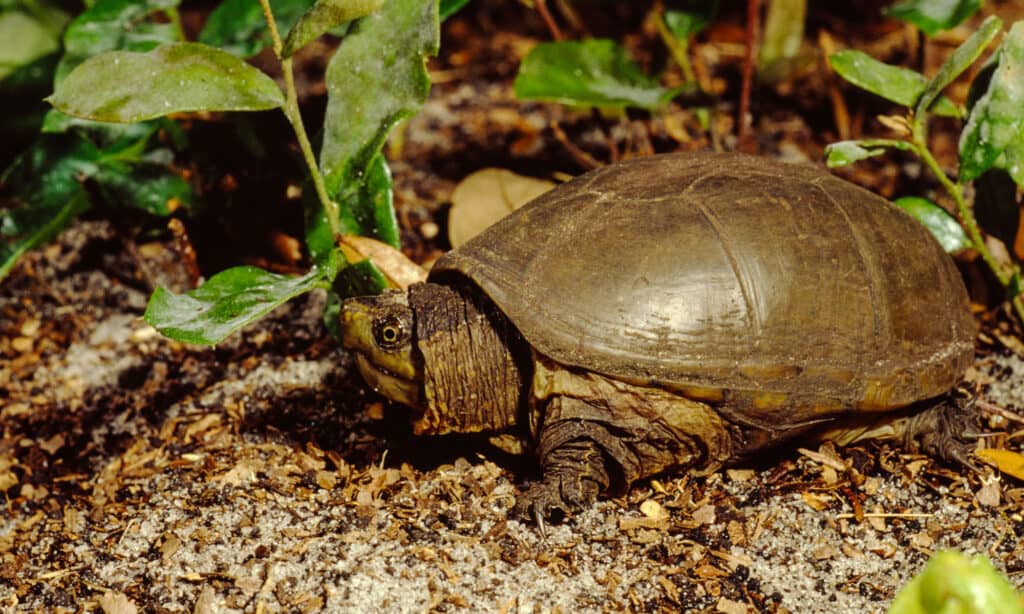
Eastern mud turtles are mostly brown but often have yellow markings on their plastrons.
©Liz Weber/Shutterstock.com
The eastern mud turtle is also known as the common mud turtle. It has two subspecies: the Mississippi and the eastern varieties.
This species is easily identified by its rounded, ovular shell and yellow markings on its chin and throat. Similar to the box turtle, the eastern mud turtle’s plastron, or the underside of its shell, has hinges that can be closed for defense. The carapace, the top portion of the shell, is typically dark brown, while the plastron is usually yellowish. The turtle ranges from 7 to 10 inches long on average.
You can find the eastern mud turtle throughout much of the eastern half of the United States and much of western Kentucky. It is quite hardy and can tolerate many habitats, including areas with brackish water. However, it prefers shallow, muddy-bottomed ponds with lots of plant cover. It often basks on debris like logs and rock piles.
As its name suggests, the eastern mud turtle is semi-aquatic and migrates seasonally to warmer regions in the winter.
3. Spiny Softshell Turtle (Apalone spinifera)

The spiny softshell’s snout is long and narrow and works perfectly as a snorkel.
©iStock.com/Brian Reinke
The spiny softshell is a bizarre-looking turtle that has to be seen to be believed! From its long, thin snout to its flat, smooth shell, the spiny softshell resembles something from science fiction than a turtle. Its common name refers to the spine-like projections on the rear end of its carapace.
As its name implies, the spiny softshell’s flat is completely flat and smooth with no individual scales or scutes. It is greyish brown to olive green in color with similarly-colored skin and has a thin, snorkel-like snout. The turtle’s carapace often has small dark spots that can either darken or fade with age. It is semi-aquatic and has webbed feet with claws.
On average, it ranges from 7 to 20 inches long, with females being much longer and larger than males. Males range from 5 to 10 inches, while females usually reach 10 to 20 inches in length.
This particular species inhabits much of the United States aside from the northwest quarter of the country, and it can be found throughout most of Kentucky. The spiny softshell can live in virtually all freshwater bodies as a fairly hardy species. Still, it prefers slow-moving, shallow waters with lots of vegetation and a sandy bottom. It migrates seasonally to warmer regions in the winter.
4. Common Snapping Turtle (Chelydra serpentina)
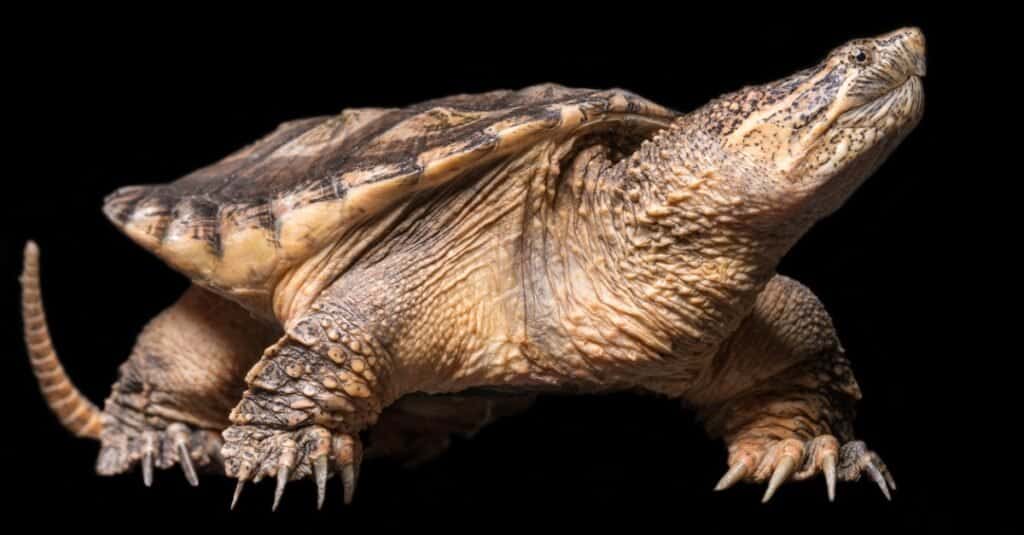
Common snapping turtles have long necks and strong, sharp claws.
©iStock.com/looderoo
True to its name, the common snapping turtle is one of North America’s most widespread turtle species. The “serpentina” part of its scientific name refers to its long, flexible, snake-like neck, which is usually tucked into its shell when it isn’t hunting prey.
As one of the world’s largest freshwater turtles, the common snapping turtle is a force to be reckoned with! Its sharp, prominent beak, clawed, webbed feet, and tough, craggy shell make it easy to identify. In terms of size, it ranges from 10 to 18 inches long on average and weighs anywhere from 20 to 80 pounds! Its carapace varies in color from grayish brown to olive green and even shades of dull orange, while its skin is usually brownish gray.
The common snapping turtle inhabits much of the American Midwest and its eastern half. This turtle can be found throughout Kentucky and is extremely hardy, so it can thrive in many habitats. It can tolerate brackish water but prefers shallow, muddy ponds and slow-moving streams.
In cooler regions, the snapping turtle hibernates underwater in the winter. It can breathe underwater via pulmonary respiration, exchanging gases and absorbing oxygen through its throat and mouth membranes.
5. Smooth Softshell Turtle (Apalone mutica)

The smooth softshell’s carapace has no scutes and is soft and leathery to the touch.
©Peter Paplanus / CC BY 2.0 – License
The smooth softshell looks quite similar to the spiny softshell at a glance, as the two species are quite closely related. However, it lacks the carapace spines of the spiny softshell and has noticeably more rounded nostrils. It still has the trademark long snorkel snout and flat shell, though!
Typically brown or grayish-brown in color, the smooth softshell usually has dark markings on its carapace. Females have larger brown blotches, while males tend to have much smaller dark brown or black spots on their shells. The species ranges from 5 to 14 inches long, with females being much longer than males. Males also have thicker tails yet shorter claws on their hind feet. Both sexes are highly aquatic and have webbed feet.
The smooth softshell’s geographic range isn’t quite as widespread as the spiny variety. It inhabits sporadic areas of the American Midwest and can be found along Kentucky’s northern and western borders. It can thrive in various habitats but is most often found in fast and slow-moving streams, wetlands, ponds, and lakes, preferring bodies of water with muddy or sandy bottoms and lots of vegetation.
In cooler regions, the smooth softshell typically hibernates during the winter months.
6. Alligator Snapping Turtle (Macrochelys temminckii)
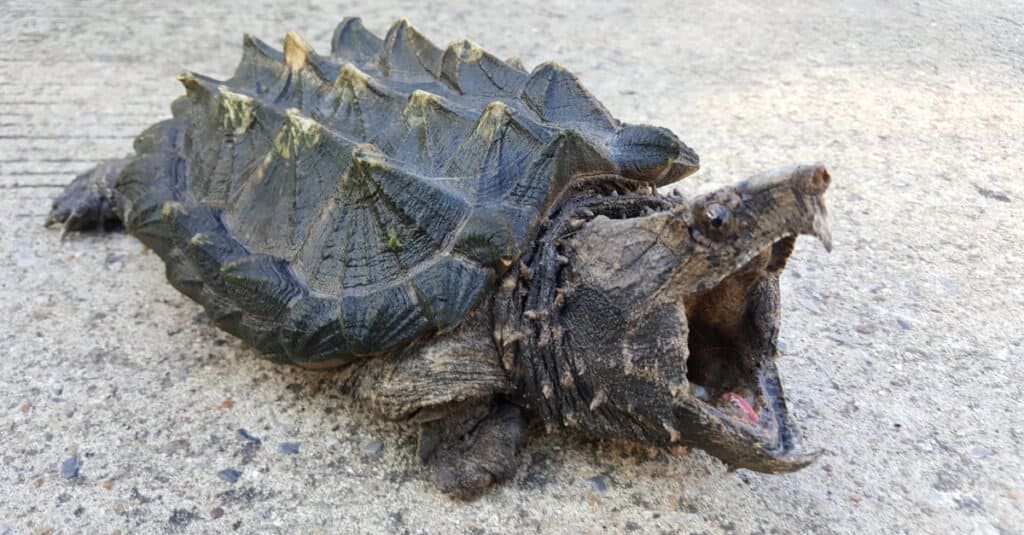
The alligator snapping turtle’s carapace is extremely textured with pyramid-shaped ridges.
©Sista Vongjintanaruks/Shutterstock.com
Though the alligator and common snapping turtles have similar common names and general appearances, the two species are not very closely related. Along with the common snapper, the alligator snapping turtle is one of the world’s largest freshwater turtles.
Thanks to its extremely textured, craggy shell, prominent, pointed beak, and wide, heavy head, this species looks like a darker and edgier version of the common snapping turtle. It is typically solid grayish brown or olive green in color with a lighter-colored plastron. It has long, clawed webbed feet and averages 15 to 30 inches in length. It’s also quite heavy, weighing anywhere from 20 to 170 pounds, with males being larger than females on average.
Also, like the common snapping turtle, the alligator snapper lives throughout much of the American Midwest and Southeast. Both it and the common snapping turtle can be found in western Kentucky. As a semi-aquatic species, it prefers bodies of water with lots of plant cover and debris.
In addition to its extremely painful bite, the alligator snapping turtle is perhaps most well-known for its “vermiform” or worm-like tongue to lure fish directly into its mouth!
7. Red-Eared Slider Turtle (Trachemys scripta elegans)
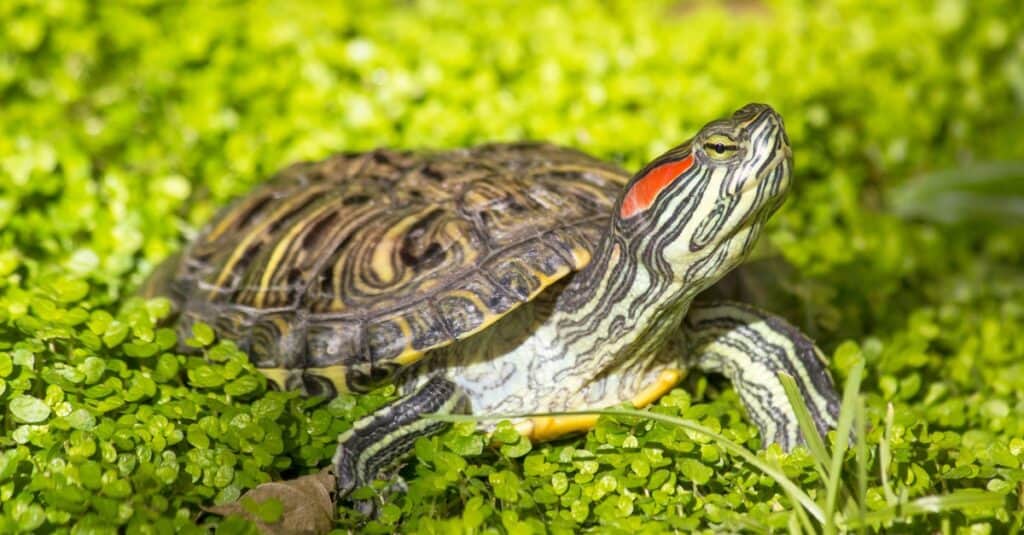
Red-eared slider turtles have bright red markings just behind their eyes.
©xbrchx/Shutterstock.com
The red-eared slider gets its name from the vibrant red markings near its ears on either side of its head. This well-known species is actually a subspecies of the pond slider turtle, Trachemys scripta. It is one of the most common turtle species in the pet trade thanks to its wide geographic range, small size, and non-aggressive nature.
The typical red-eared slider ranges from around 6 to 10 inches long on average, but they can reach up to 15 inches in length. Females of the species are larger than males, and both sexes undergo a slight change in color as they age. They have green and yellow striped skin with a mostly grayish brown to olive green carapace. The underside of the turtle’s shell, the plastron, is yellowish with dark green or brown markings. It is semi-aquatic and has webbed and clawed feet.
Red-eared sliders are distributed throughout the US, mainly in parts of the Midwest, Southeast, and even the west coast. It is one of Kentucky’s most common turtles. Its range extends south of Florida and Mexico and as far north as southern Canada! Its preferred habitats are small, slow-moving, or still bodies of water like ponds, streams, and marshes. It is never far from water and often basks on logs and rocks.
In the winter, this species usually brumates when temperatures drop below 50F.
8. Ouachita Map Turtle (Graptemys ouachitensis)
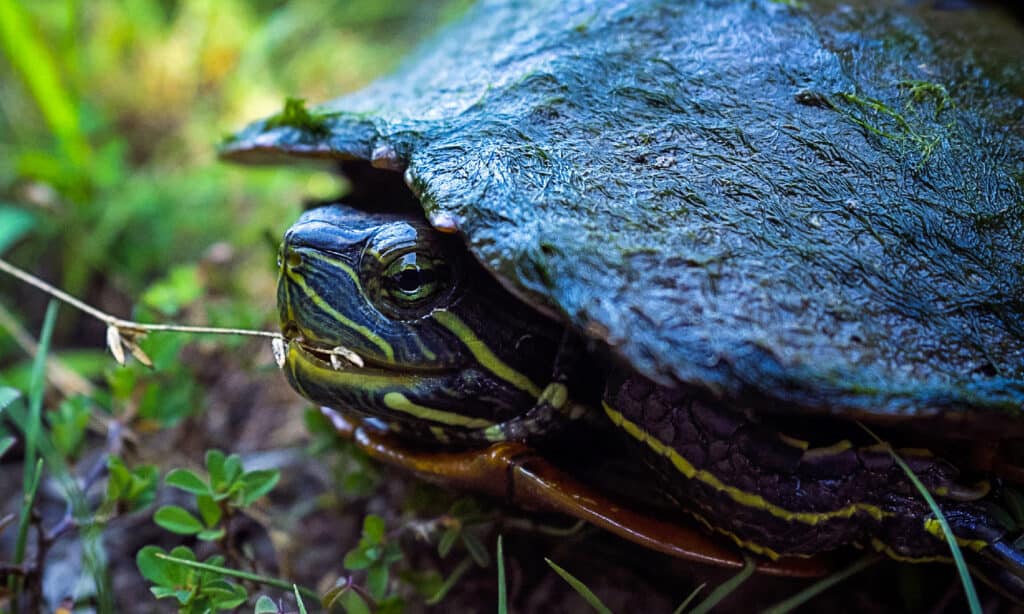
The Ouachita map turtle has yellow striped skin.
©Stephanie’screativeImages/Shutterstock.com
The Ouachita map turtle is closely related to the aforementioned common map turtle. Both turtles live in Kentucky and are classified within the same genus: Graptemys.
This species is most easily identified by the raised, spine-like ridges in the center of its carapace. Its shell is usually grayish brown or olive green with yellow and greenish markings. The underside of the shell, the plastron, is yellowish or off-white with small, dark, irregular markings. Its skin is brownish-gray with thin, vibrant yellow striping. The average Ouachita map turtle ranges from 4 to 10 inches long, with males being much smaller than females. It also often has yellow markings on the head around its eyes.
Ouachita map turtles are common throughout much of the southern Midwest, with their geographic range extending down into Louisiana and Mississippi. It can be found mainly in western and northern Kentucky. As a highly aquatic species, it prefers river habitats.
9. Common Musk Turtle (Sternotherus odoratus)

The common musk turtle can release a nasty-smelling odor from its scent glands to deter predators.
©Ryan M. Bolton/Shutterstock.com
This smelly-sounding turtle has certainly earned its name! It is also often referred to as the “stinkpot” turtle, thanks to the scent glands on the sides of its shell, which can release a foul odor as a defense mechanism.
The common musk turtle has a rounded, high-domed carapace that is usually dark brown or grey. It is quite small at just 3 to 5 inches long on average, but it has a long neck for its size. Its skin is yellow and green striped along its head but grayish brown elsewhere. Females are larger on average, but males have longer tails with a spike at the end.
You can generally find common musk turtles throughout much of Kentucky and the eastern half of the United States. They prefer shallow, muddy, slow-moving bodies of water like ponds and streams. In the winter, they burrow in the mud to hibernate and can breathe underwater using their tongues!
10. Eastern Box Turtle (Terrapene carolina carolina)

Box turtles have hinged plastrons that they can use to lock themselves into their shells for defense.
©Jessica Baldwin/Shutterstock.com
We’ll end this list with the small yet well-loved eastern box turtle, a subspecies of the common box turtle. It is mainly known for its unusual defense mechanism: the front and back of the underside of the turtle’s shell have fully-functioning hinges that the turtle can use to shut itself into its protective “box” tightly. Moreover, its shell can repair itself over time, making it an extremely reliable defense mechanism.
Easily recognizable for its hinged plastron and high, rounded, dome-like carapace, the eastern box turtle varies wildly in color from mottled brown and grey to yellowish and even orange markings. Skin color also varies, typically brown with yellow, orange, or white markings. It ranges from 4 to 8 inches in length and is more terrestrial than most of Kentucky’s other turtle species.
True to its name, this subspecies is found throughout the eastern United States and most of Kentucky. Its preferred habitat is dense forests with lots of leaf litter and plant cover.
Up Next:
The photo featured at the top of this post is © xbrchx/Shutterstock.com
Thank you for reading! Have some feedback for us? Contact the AZ Animals editorial team.







